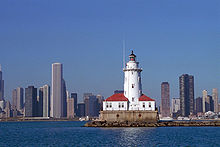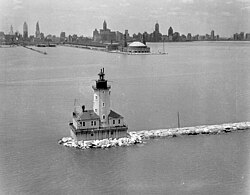Chicago Harbor Lighthouse
 |
|
| Location | Chicago, Illinois |
|---|---|
| Year first constructed | 1893, moved 1919 |
| Year first lit | 1893 |
| Automated | 1979 |
| Foundation | Rubble stone with concrete pier |
| Construction | Brick, cast iron and glass |
| Tower shape | Cylindrical base/Frustum of a cone tower, with attached buildings |
| Markings / pattern | White, red on roofs |
| Height | 66 ft (20 m) tower |
| Focal height | Focal plane – 82 feet (25 m) |
| Original lens | Third-order Fresnel |
| Range | 24 miles (39 km) |
| Characteristic |
Fl R 5s floodlighted. Apr. to Dec. Horn: 2 blasts ev 30 s (1 s bl). Operates from April to Dec |
| ARLHS number | USA-171 |
| USCG number |
7-19960 |
|
Chicago Harbor Lighthouse
|
|

1930s U.S. Coast Guard photo of the light
|
|
| Location | North Breakwater, Chicago, Illinois |
| Coordinates | 41°53′22″N 87°35′26″W / 41.88944°N 87.59056°WCoordinates: 41°53′22″N 87°35′26″W / 41.88944°N 87.59056°W |
| Area | 1 acre (0.40 ha) |
| Built | 1893 |
| Architect | United States Lighthouse Board |
| MPS | U.S. Coast Guard Lighthouses and Light Stations on the Great Lakes TR |
| NRHP Reference # | 84000986 |
| Significant dates | |
| Added to NRHP | July 19, 1984 |
| Designated CL | April 9, 2003 |
Fl R 5s floodlighted. Apr. to Dec.
7-19960
The Chicago Harbor Lighthouse is an automated active lighthouse, and stands at the south end of the northern breakwater protecting the Chicago Harbor, to the east of Navy Pier and the mouth of the Chicago River.
The light was constructed in 1893 for the World's Columbian Exposition and moved to its present site in 1919. The United States Lighthouse Board prominently displayed "its 'state of the art' wares and engineering achievements." Prominently featured was "the engineering marvel" of Spectacle Reef Light and a 111-foot-tall (34 m) skeletal cast iron lighthouse tower.
Also displayed at the Exposition were a number of Fresnel lenses, including a stunning Third Order Fresnel lens which was awarded first prize at a Paris glass exhibition. The lens featured alternating red and white panels, and had been ordered for installation in the New Point Loma Lighthouse in California. The coincidental conclusion of construction of the new Chicago Harbor light and the close of the Exhibition prompted the Lighthouse Board to keep the lens in Chicago, and thus the lens was installed in the lantern room of the new tower. The original lens has since been removed, and is now on display at Cabrillo National Monument in California.
Surrounded by rip rap, the structure has several levels: a concrete base and two red roofed buildings with a tapered white cylinder between them which is topped by a parapet and the light itself.
In 1917 the breakwater was renovated. At that time, the lighthouse was moved to its present site, and its attached fog signal room and boathouse were built.
...
Wikipedia

